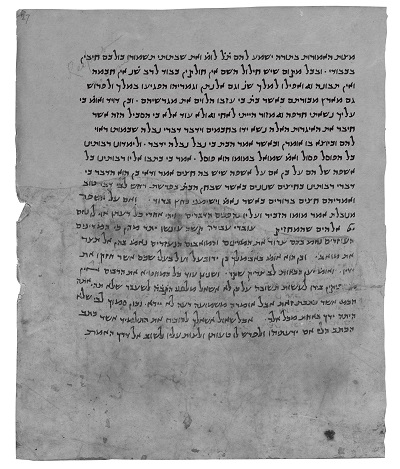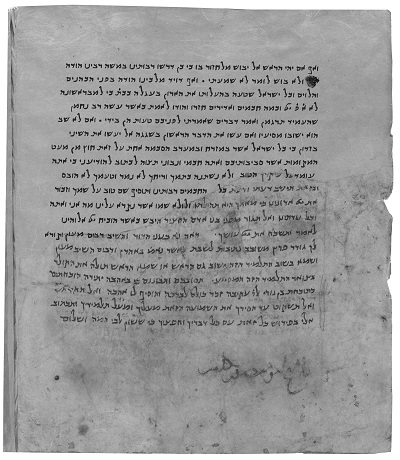Reconstructing folios from text editions: Lévi (1900) + T-S NS 98.18 and Bodl. MS Heb d.74.27
Sacha Stern and Jay Birbeck (UCL)
Joining fragments is commonplace in Genizah research; less common is joining fragments with edited text.
The two folios in question, part of a larger manuscript that Sacha Stern is currently editing,[1] were torn horizontally, probably before they even left the Cairo Genizah. One of the lower fragments ended up in Cambridge, and the other in the Bodleian Library in Oxford. The upper fragments have not survived, but they were seen by Israel Lévi at the great exhibition of Paris in 1900, at the stall of a merchant from Cairo. Lévi copied out the text and promptly published it, but without saying what happened to the fragments.[2] They may have remained in the hands of the merchant, or they may have been sold. Sacha Stern has searched for them in vain, in Paris and elsewhere; the assumption must be that they are lost. All that we have of them now is Lévi’s edition.
Fig. 1 Lévi's edition (1900), folio 2 recto (from line2)
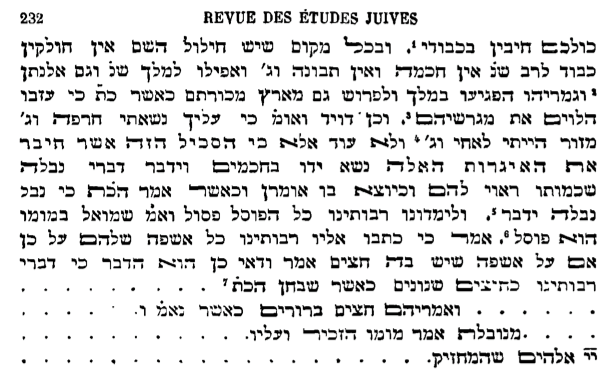
It was only in 1934 that Jacob Mann realized that Lévi’s second fragment was the upper half of Bodleian manuscript, MS Heb d.74.27.[3] Stern re-discovered this independently, and also joined the first fragment of Lévi with T-S NS 98.18, a Cambridge fragment of the same manuscript, that he had previously discovered in 2014. Then in 2015, he discovered, with Marina Rustow, a complete folio in Cambridge of the same manuscript, which immediately preceded Lévi’s text (T-S 10J32.1). The result was three continuous folios:
1. T-S 10J32.1, textually complete;
2. Lévi fgm 1 + T-S NS 98.18, two fragments joined but with an estimate gap of three lines between them;
3. Lévi fgm 2 + Bodl. MS Heb d.74.27, a perfect join.
These three folios, thus joined, contain the copy of a Hebrew letter that was written in 922 by someone most likely in Syria or Palestine. This can be told by his dating from the destruction of the Temple, a chronological era which was never used in Babylonia or further east. The letter concerns the controversy about the calendar and dates of the festivals that was raging, in 921/2, between Palestinian and Babylonian Rabbanite leaders (a controversy that has been known until now as ‘between Saadya and ben Meir’; but the role of Saadya was actually marginal). Although a Westerner, the author of this letter sides with the Babylonians, and reproaches his correspondent for appearing to support the Palestinians.
The rest of the manuscript contains further letters written in the same year, on both the Babylonian and Palestinian sides of the controversy. Most of the fragments that make up these folios were joined by Alfred Guillaume in 1915, but an additional fragment was discovered and joined by Marina Rustow in 2012 (T-S NS 309.68b).[4] The manuscript as a whole, which Stern calls the ‘Letters Miscellany’, now counts a total of nine folios. It can be dated, by its handwriting, to around 1100.[5]
On close analysis of Lévi’s edition, it was clear that he had not preserved the text alignment of the original. His lines were too neatly justified, more likely the result of modern typesetting than a reflection of what was found in the manuscript. His lines also appeared shorter than the lines of text in the surviving fragments. This led Stern to wonder how, in fact, the original manuscript would have looked.
In the summer of 2018, Stern teamed up with Jay Birbeck, a UCL MA student in Digital Humanities, to reconstruct an image of the upper half of the folios on the basis of Lévi’s edition. The purpose of the exercise was not merely cosmetic, but to establish as precisely as possible how Lévi’s text would have joined the lower fragments. In addition, this reconstruction would enable us to conjecture how the text of Lévi was originally aligned.
It became immediately evident that the use of pre-existing fonts would not be helpful. The different fonts we tried could not produce a textual layout that matched or joined up with the lower fragments, nor could they be used to reconstruct the characters that had been torn across on the edge of the fragments. The only solution was to create a unique, bespoke font that imitated the handwriting of the manuscript. This font would enable us to join Lévi’s text seamlessly with the existing fragments, and to produce a semblance of how the lost fragments would have looked.
The first step was to create a Hebrew alphabet using samples from the extant manuscript. Because of significant variations in the handwriting, a decision had to be taken as to which samples in the manuscript to choose for each letter of the alphabet. In the absence of objective criteria, the decision had to be somewhat arbitrary. We avoided using characters that appeared unrepresentative or unusual in the manuscript in terms of dimensions, shape, and internal proportions. We could have created several versions of each character of the alphabet, based on different samples in the manuscript, and randomised their use in the text. We decided, however, that this level of complication was not essential for creating a reasonable reconstruction of the Lévi fragments. We therefore settled for a single version of each letter of the alphabet – a decision that we reconsidered, however, later (see below).
To extract the graphemes from images of the manuscript, Birbeck used a method called thresholding, which generates binary images consisting of black and white pixels only (see Figure 1). When the process was applied to the manuscript, all but the text and other dark blemishes turned white, making the graphemes easier to extract. However, the edges of the graphemes were jagged and would require smoothing before being converted into a font.
Figure 2: Extracting and editing the graphemes

To smooth out the edges, Birbeck converted the graphemes into vector shapes. Vector shapes are made up of points connected by lines and curves, which make them more malleable than pixilated images. When smoothing out the edges we took care to avoid changing the shape of the letter. The relative size of each grapheme was then adjusted, as well as their positions on the base line, and the spacing between them.
Once the graphemes were sufficiently edited, Birbeck was able to convert them into a typeface. He used the Fontself Maker extension for Adobe Illustrator to assign the graphemes to their corresponding unicode characters.
This process was applied not only to the letters of the alphabet, but also to special graphemes that are characteristic of this manuscript and presumably appeared, similarly, in Lévi’s text (even if Lévi did not indicate this in his edition). Thus for the name of God, the grapheme that is used in this manuscript consists of two yods with the final stroke turning upwards and then backwards over the two characters. For the abbreviation of וגומר (‘etc.’), the scribe writes waw and gimel, and continues the final stroke with a backtracking, diagonal line across the gimel. Fonts were created for these graphemes too (see the last two characters in Figure 3).
Figure 3: The fonts
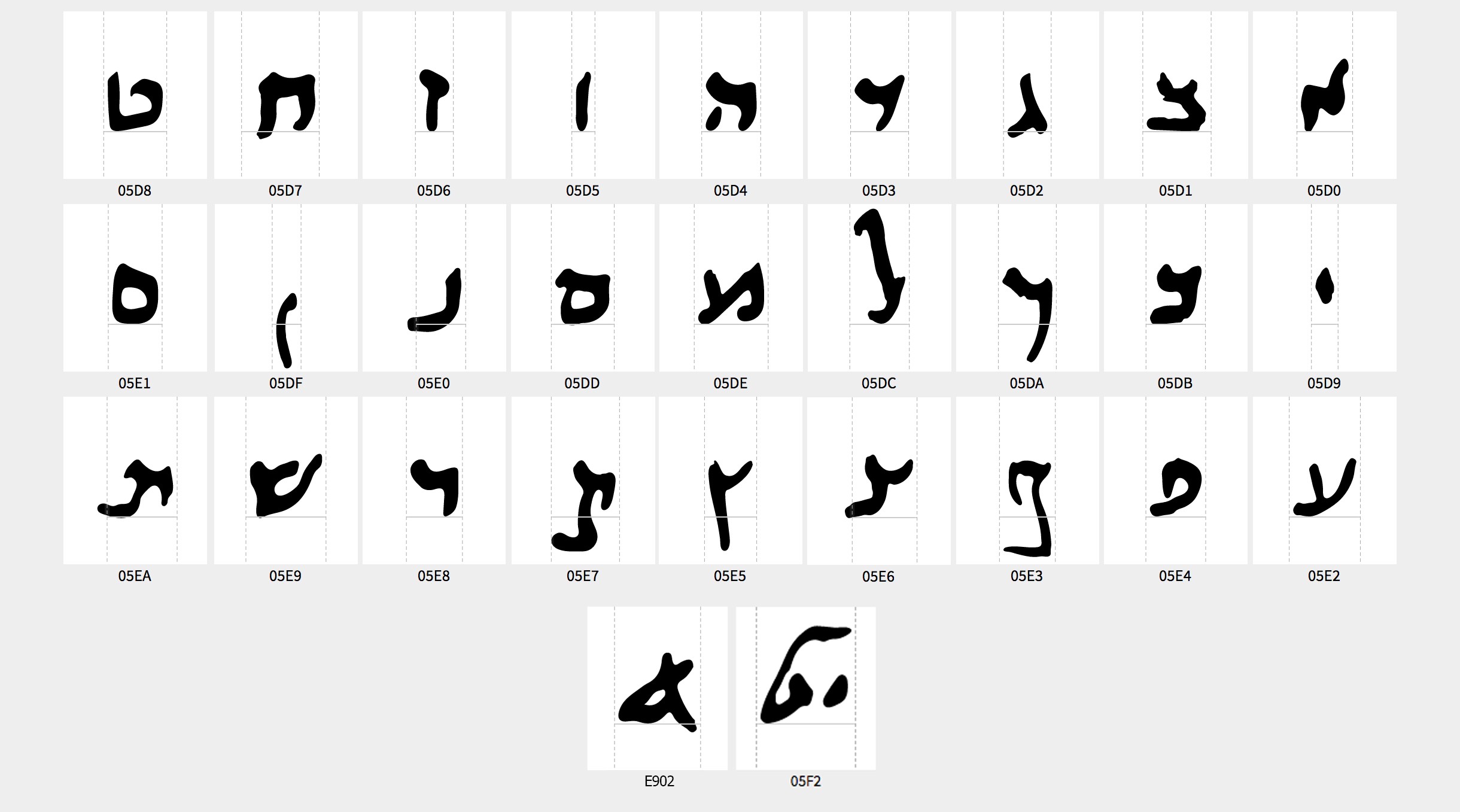
A feature of some characters in this manuscript, such as nun (05E0), tsade (05E6), and taw (05EA), is that they are often joined to the following character (e.g., typically, nun-waw) or sometimes extend below it. Replicating this was relatively easy, as the glyph editor, which Birbeck used in Fontself Maker, allows for the adjustment of each character's side bearings and vertical metrics. The spacing between these characters was thus simple to adjust: their left margin was sufficiently reduced for the character to overlap with the next glyph. Although this method was effective, some manual editing in Photoshop was still necessary after the text was laid, to achieve more accurate results. In future, we would consider creating ligatures instead, such as nun-waw, sampled from the manuscript in the same way as the individual letters. This would not necessarily reduce our work, but it could increase the accuracy of the font.
To enhance the realism of the images, Birbeck created a simulated paper background. He copied the lower fragment, and removed all text and blemishes from the paper, using the Spot Healing Brush Tool in Photoshop. This yielded a clean fragment of paper on which to lay the text. The shape of the fragment was altered with the manipulation tools in Photoshop, to distinguish it from the lower fragment. The bottom edge of the simulated paper, along the tear, was carefully designed to fit the lines of reconstructed text after it had been laid. When the recto side was completed to our satisfaction, it was mirrored for the verso side. Small adjustments were necessary to accommodate the text layout on the verso side. Blemishes and ink stains were reinserted, to achieve a more realistic effect. A blot of ink was added at the beginning of line 2 of Lévi fgm 2 verso, where Lévi indicates, in his edition, that a small piece of text is missing (i.e. presumably illegible, which we conjecture was due to a stain). To avoid misrepresentation, we used the images as they had been procured to us by the libraries, CUL and Bodleian – hence their different colouring.
One of our main challenges was laying out the text. Our guiding principle was to ignore Lévi’s edition, whose alignment was clearly not authentic, and instead to imitate, with our created font, the layout and spacing of the extant manuscript. This eventually led to a significant reduction in the number of lines. The complete lines of text in Lévi’s edition, which we established were too short, number 10 (fgm 1 recto), 10 (fgm 1 verso), 11 (fgm 2 recto), and 9 (fgm 2 verso); this became, in our reconstruction, 8, 9, 9, and 8 lines respectively. The total number of lines which we obtained in the joined folios is closer to what is found in the rest of the manuscript.
In order to obtain complete lines, with the text justified along the left (as in the rest of the manuscript), it was necessary in some cases to adjust manually the font size and letter spacing of the graphemes. This was especially needed in the lines which straddle Lévi fgm 2 and Bodl. manuscript, MS Heb d.74.27, at the point where both fragments join: in each of these fragmentary lines, the quantity of text in Lévi’s edition could not be altered, and therefore had to be adapted to the space available.
At the point where both fragments join, careful attention was also given to small fragments of letters that survived in the lower fragment, but were hitherto not noticed (e.g. in Guillaume’s edition). Thus in Lévi fgm 2 + Bodl. MS Heb d.74.27 recto, lines 12–13 of our reconstruction, just above the line of the tear, the text reads as follows:

woe unto him, says
the Lord God,[6] for whoever lends support to transgressors, his punishment is greater than theirs
The stepped line marks the division between the upper fragment (here on the right), i.e. Lévi’s edition, and the lower, extant fragment (here on the left). On the upper edge of the lower fragment, to the right, we noted part of a descender, which could only have belonged to the qof of שהמחזיק (there is no other descender in this area). Accordingly, we laid the text so as to align the qof with this fragmentary descender. This resulted in an unusual gap after שהמחזיק, which we have left blank in our reconstruction. The Hebrew is awkward; Mann (1934) already conjectured that the word בידי might be missing after שהמחזיק, and may have been accidentally omitted by Lévi. Our reconstruction, with an apparent gap after שהמחזיק, supports Mann’s conjecture.
Finally, after the text was laid, Birbeck altered the kerning, width, height and letter spacing of many graphemes to simulate the variation inherent to handwritten text. This task, which effectively compensated for our decision to use a single sample for each letter of the alphabet, was particularly labour intensive. This made us reconsider the wisdom of our earlier decision. In future, we would explore automating grapheme variation, by designing a font that could support several versions of each grapheme.
Figures 4–7: the reconstructed folios (lower fragments are original, upper fragments are reconstructed)
Fig.4 Lévi fgm 1 recto + T-S NS 98.18 recto
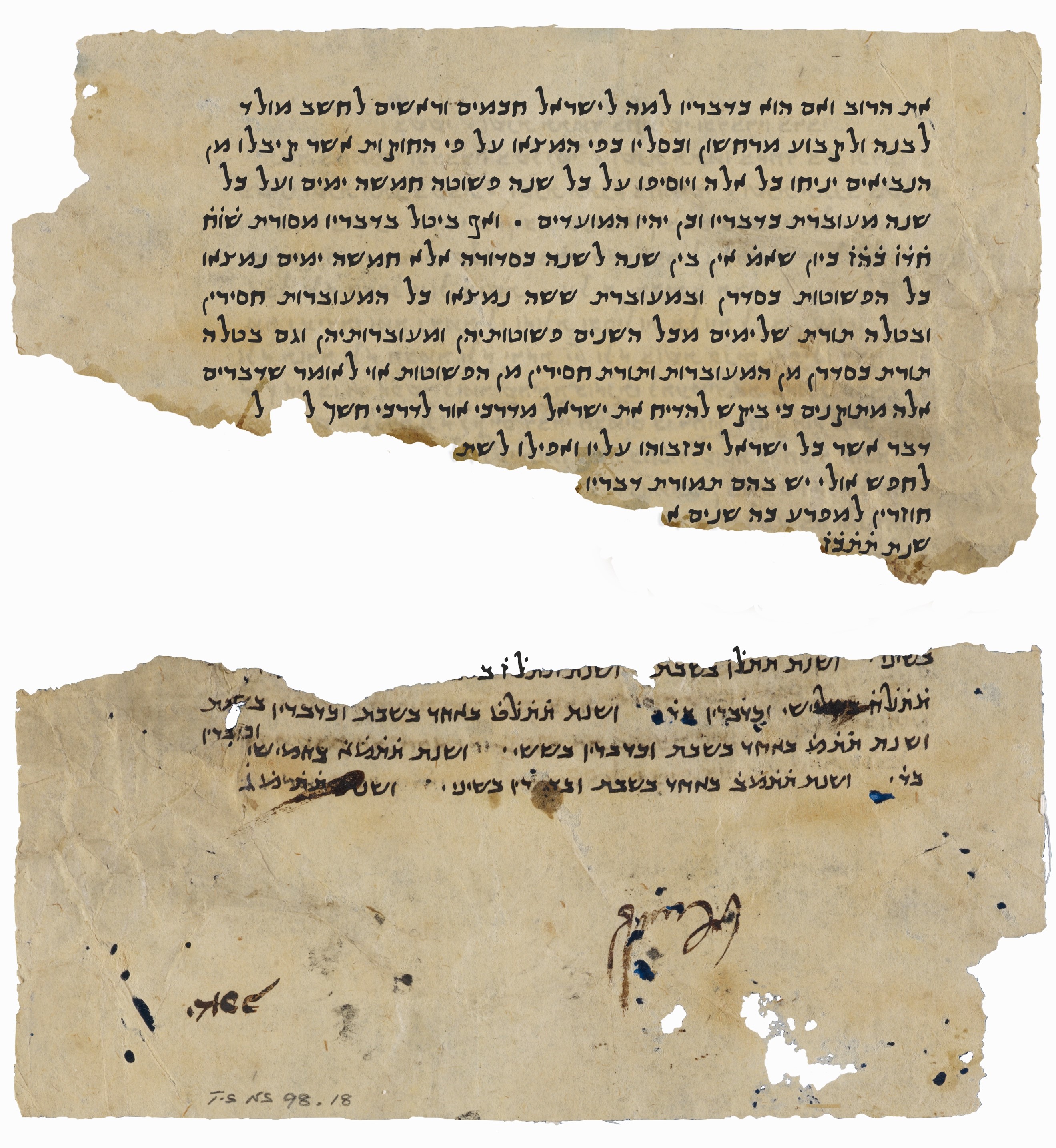
Fig. 5 Lévi fgm 1 verso + T-S NS 98.18 verso
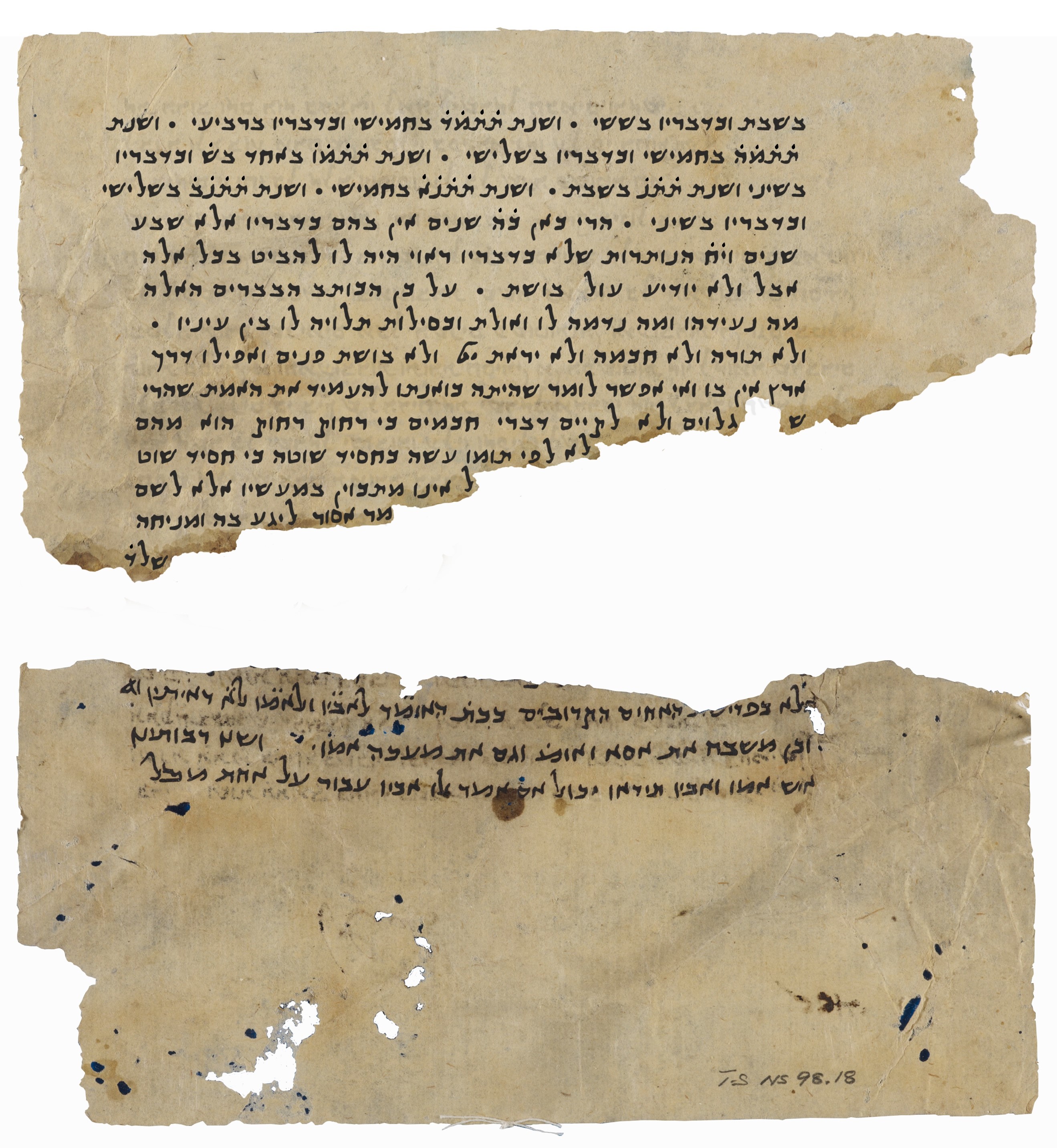
Fig.6 Lévi fgm 2 recto + Bodl. MS Heb d.74.27 recto
(Bodl. MS Heb d.74.27 recto reproduced by kind permission of the Bodleian Libraries, University of Oxford)
Fig. 7 Lévi fgm 2 verso + Bodl. MS Heb d.74.27 verso
(Bodl. MS Heb d.74.27 verso reproduced by kind permission of the Bodleian Libraries, University of Oxford)
Footnotes
[1] In a monograph entitled The Jewish Calendar Controversy of 921/2, Brill, forthcoming (2019). The project was funded by the British Academy and the ERC, and run in collaboration with Marina Rustow (Princeton).
[2] I. Lévi, ‘Nouveaux fragments relatifs à ben Méïr’, Revue des Etudes Juives, 41 (1900), 229-32.
[3] J. Mann, ‘Varia on the Gaonic period: I. On the history of the Gaonate in the X century’, Tarbiz 5.2, 148-79, and 5.3-4, 273-304 (1934) [Hebrew]
[4] A. Guillaume, A., ‘Further documents on the Ben-Meir controversy’, Jewish Quarterly Review n.s. 5 (1915), 543-57. The upper fragments of Guillaume’s joins, T-S 13K2.1–6, were originally published by Solomon Schechter in Saadyana. Geniza Fragments of Writings of R. Saadya Gaon and Others, Cambridge (1903). Guillaume joined four of these upper fragments to Bodl. MS Heb d.74.28-31. A fifth of these upper fragments was joined in 2012 to T-S NS 309.68b.
[5] Dating courtesy of Judith Olszowy-Schlanger and Amir Ashur.
[6] Cf Ezekiel 16:23.
Cite this article
(2018). Reconstructing folios from text editions: Lévi (1900) + T-S NS 98.18 and Bodl. MS Heb d.74.27. [Genizah Research Unit, Fragment of the Month, November 2018]. https://doi.org/10.17863/CAM.40133
If you enjoyed this Fragment of the Month, you can find others here.
Contact us: genizah@lib.cam.ac.uk
The zoomable images are produced using Cloud Zoom, a jQueryimage zoom plugin:
Cloud Zoom, Copyright (c) 2010, R Cecco, www.professorcloud.com
Licensed under the MIT License

